Related Research Articles

A Fire Upon the Deep is a 1992 science fiction novel by American writer Vernor Vinge. It is a space opera involving superhuman intelligences, aliens, variable physics, space battles, love, betrayal, genocide, and a communication medium resembling Usenet. A Fire Upon the Deep won the Hugo Award in 1993, sharing it with Doomsday Book by Connie Willis.
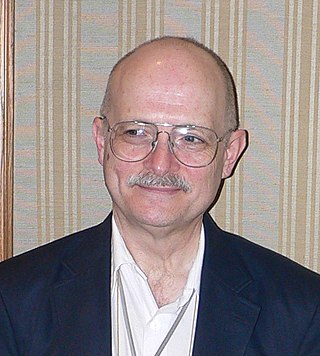
Vernor Steffen Vinge was an American science fiction author and professor. He taught mathematics and computer science at San Diego State University. He was the first wide-scale popularizer of the technological singularity concept and among the first authors to present a fictional "cyberspace". He won the Hugo Award for his novels A Fire Upon the Deep (1992), A Deepness in the Sky (1999), and Rainbows End (2006), and novellas Fast Times at Fairmont High (2001) and The Cookie Monster (2004).
The technological singularity—or simply the singularity—is a hypothetical future point in time at which technological growth becomes uncontrollable and irreversible, resulting in unforeseeable consequences for human civilization. According to the most popular version of the singularity hypothesis, I. J. Good's intelligence explosion model of 1965, an upgradable intelligent agent could eventually enter a positive feedback loop of self-improvement cycles, each successive; and more intelligent generation appearing more and more rapidly, causing a rapid increase ("explosion") in intelligence which would ultimately result in a powerful superintelligence, qualitatively far surpassing all human intelligence.

True Names is a 1981 science fiction novella by American writer Vernor Vinge, a seminal work of the cyberpunk genre. It is one of the earliest stories to present a fully fleshed-out concept of cyberspace, which would later be central to cyberpunk. The story also contains elements of transhumanism.

Joan D. Vinge is an American science fiction author. She is known for her Hugo Award–winning novel The Snow Queen and its sequels, her series about the telepath named Cat, and her Heaven's Chronicles books. She also is the author of The Random House Book of Greek Myths (1999).
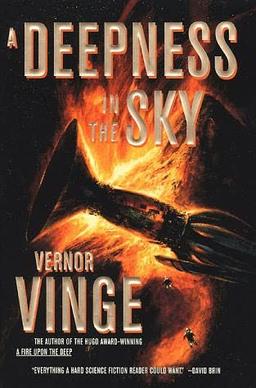
A Deepness in the Sky is a science fiction novel by American writer Vernor Vinge. Published in 1999, the novel is a loose prequel to his earlier novel A Fire Upon the Deep (1992). The title is coined by one of the story's main characters in a debate, in a reference to the hibernating habits of his species and to the vastness of space.

Marooned in Realtime is a 1986 murder mystery and time-travel science fiction novel by American writer Vernor Vinge, about a small, time-displaced group of people who may be the only survivors of a technological singularity or alien invasion. It is the sequel to the novel The Peace War (1984) and the novella The Ungoverned (1985). Both novels and the novella were collected in Across Realtime.
"Solution Unsatisfactory" is a 1941 science fiction alternate history short story by American writer Robert A. Heinlein. It describes the US effort to build a nuclear weapon in order to end the ongoing World War II, and its dystopian consequences to the nation and the world.

James Raymond Frenkel is an American editor and agent of science fiction, fantasy, mysteries, thrillers, historical fiction, and other books, formerly for Tom Doherty Associates. He has edited numerous prominent authors such as Vernor Vinge, Joan D. Vinge, Frederik Pohl, Andre Norton, Loren D. Estleman, Dan Simmons, Jack Williamson, Timothy Zahn, Marie Jakober and Greg Bear. His agency clients include John C. Wright and L. Jagi Lamplighter. He and his wife, author Joan D. Vinge lived in Madison, Wisconsin for many years, but have moved to Chapel Hill, North Carolina.
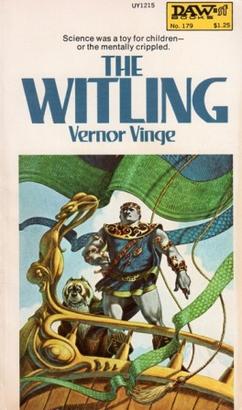
The Witling is a 1976 science fiction novel by American writer Vernor Vinge, about the planet Giri, whose humanoid inhabitants, the Azhiri, are able to teleport. This ability varies from person to person: those without the talent at all are called witlings and are the lowest class of person in Azhiri society.

The Collected Stories of Vernor Vinge is a collection of science fiction short stories by American writer Vernor Vinge. The stories were first published from 1966 to 2001, and the book contains all of Vinge's published short stories from that period except "True Names" and "Grimm's Story".
"Bookworm, Run!" is a science fiction short story by American writer Vernor Vinge. His second published work of fiction, it appeared in Analog Science Fiction Science Fact in 1966, and was reprinted in True Names... and Other Dangers in 1987, and in 2001's The Collected Stories of Vernor Vinge.
A group mind, group ego, mind coalescence, or gestalt intelligence in science fiction is a plot device in which multiple minds, or consciousnesses, are linked into a single collective consciousness or intelligence.

The 1976 Annual World's Best SF is an anthology of science fiction short stories edited by Donald A. Wollheim and Arthur W. Saha, the fifth volume in a series of nineteen. It was first published in paperback by DAW Books in May 1976, followed by a hardcover edition issued in August of the same year by the same publisher as a selection of the Science Fiction Book Club. For the hardcover edition the original cover art of Jack Gaughan was replaced by a new cover painting by Chet Jezierski. The paperback edition was reissued by DAW in December 1981 under the variant title Wollheim's World's Best SF: Series Five, this time with cover art by Oliviero Berni. A British hardcover edition was published by Dennis Dobson in March 1979 under the variant title The World's Best SF 3.
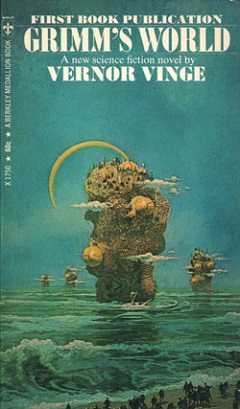
Grimm's World is a 1969 science fiction novel by Vernor Vinge.

Tatja Grimm's World is a 1987 science fiction novel by American author Vernor Vinge.

The Saga of Shadows is a trilogy of space opera novels written by Kevin J. Anderson. First announced in 2011, it is a sequel to Anderson's seven-book series, The Saga of Seven Suns (2002–2008). The first novel, The Dark Between the Stars, was released by Tor Books on June 3, 2014. The second book in the series, Blood of the Cosmos, was published on June 2, 2015. The third novel, called Eternity's Mind, was released on September 13, 2016.
Mirabile is a 1991 science fiction novel by American writer Janet Kagan. It is a fix-up of her short stories set on the planet Mirabile, which were originally published in Asimov's Science Fiction beginning in 1989; the compilation was published by Tor Books.
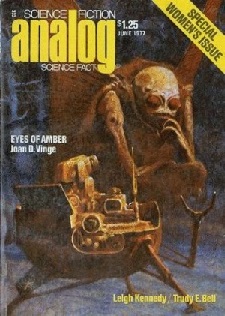
"Eyes of Amber" is a science fiction short story by American writer Joan D. Vinge. It was first published as the cover story for the June 1977 issue of Analog Science Fiction and Fact.
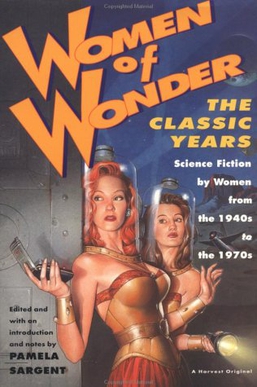
Women of Wonder, The Classic Years: Science Fiction by Women from the 1940s to the 1970s is an anthology of short stories, novelettes, and novellas edited by Pamela Sargent. It was published in 1995, along a companion volume, Women of Wonder, The Contemporary Years: Science Fiction by Women from the 1970s to the Present.
References
- ↑ Martians and Misplaced Clues: The Life and Work of Fredric Brown, by Jack Seabrook; published 1993 by Popular Press
- ↑ Introduction to "The Peddler's Apprentice" in The Collected Stories of Vernor Vinge, by Vernor Vinge, published 2002 by Tor Books
- ↑ A Survey of Some of the Best Science Fiction Ever Published (Thanks to Judy-Lynn Del Rey), by James Nicoll, at Tor.com; published August 13, 2018; retrieved August 16, 2018